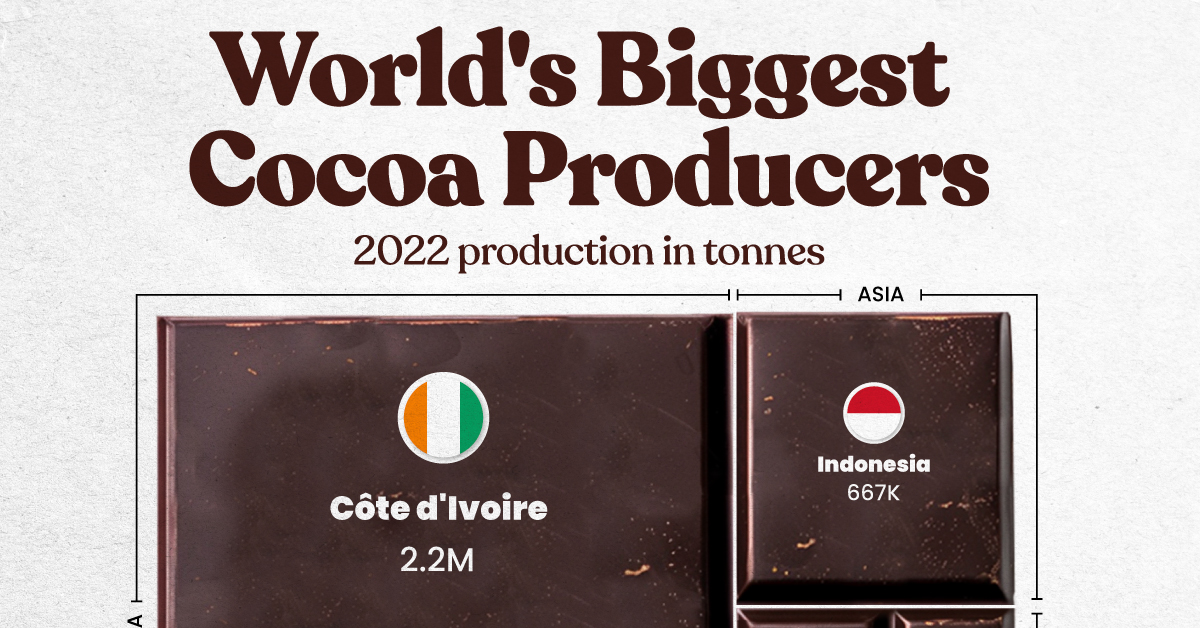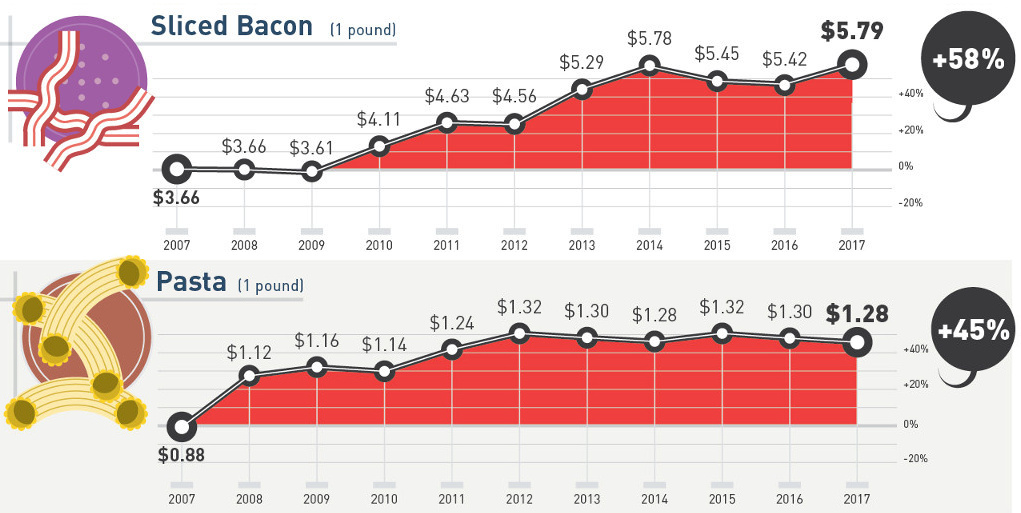Agriculture
A Decade of Grocery Prices for 30 Common Items

A Decade of Grocery Prices for 30 Common Items
Over the span of 2000-2016, the amount of money spent on food by the average American household increased from $5,158 to $7,203, which is a 39.6% increase in spending.
Despite this, for most of the U.S. population, food actually makes up a decreasing portion of their household spending mix because of rising incomes over time. Just 13.1% of income was spent on food by the average household in 2016, making it a less important cost than both housing and transportation.
That said, fluctuations in food prices can still make a major impact on the population. For lower income households, food makes up a much higher percentage of incomes at 32.6% – and how individual foods change in price can make a big difference at the dinner table.
Fluctuating Grocery Prices
Today’s infographic comes from TitleMax, and it uses data from the Bureau of Labor Statistics to show the prices for 30 common grocery staples over the last decade.
We’ve summarized the statistics in the following table to show the grocery prices in 2007 and 2017, as well as the total percentage change.
| Grocery item | 2007 price | 2017 price | % Change |
|---|---|---|---|
| Sliced bacon | $3.66 | $5.79 | 58.2% |
| Pasta | $0.88 | $1.28 | 45.5% |
| Dried beans | $0.94 | $1.36 | 44.7% |
| Ground beef | $2.85 | $4.12 | 44.6% |
| All-purpose flour | $0.36 | $0.52 | 44.4% |
| Creamy peanut butter | $1.79 | $2.56 | 43.0% |
| Top round steak | $4.11 | $5.78 | 40.6% |
| Potatoes | $0.52 | $0.72 | 38.5% |
| Frozen turkey | $1.15 | $1.59 | 38.3% |
| Sirloin steak | $5.97 | $8.07 | 35.2% |
| White rice | $0.55 | $0.72 | 30.9% |
| Chocolate chip cookies | $2.70 | $3.47 | 28.5% |
| Seedless grapes | $2.09 | $2.67 | 27.8% |
| Sugar | $0.51 | $0.65 | 27.5% |
| Ice cream | $3.95 | $4.70 | 19.0% |
| Wheat bread | $1.71 | $1.99 | 16.4% |
| Red delicious apples | $1.12 | $1.29 | 15.2% |
| Tomatoes | $1.65 | $1.90 | 15.2% |
| Broccoli | $1.59 | $1.81 | 13.8% |
| White bread | $1.20 | $1.34 | 11.7% |
| American cheese | $3.84 | $4.28 | 11.5% |
| Salted butter | $3.07 | $3.38 | 10.1% |
| Bananas | $0.51 | $0.56 | 9.8% |
| Lemons | $1.86 | $2.01 | 8.1% |
| Boneless pork chop | $3.60 | $3.82 | 6.1% |
| Navel oranges | $1.28 | $1.33 | 3.9% |
| Strawberries | $2.20 | $2.21 | 0.5% |
| Boneless chicken breast | $3.43 | $3.21 | -6.4% |
| Whole milk | $3.50 | $3.24 | -7.4% |
| Eggs | $1.68 | $1.43 | -14.9% |
Only prices of three items fell: chicken breasts (-6.4%), whole milk (-7.4%), and eggs (-14.9%).
However, the average price increase for all items was 22%, buoyed especially by meats like bacon (58.2%), ground beef (44.6%), top round steak (40.6%), frozen turkey (38.3%) and sirloin steak (35.2%).
The Future of Food
As we’ve previously noted, technology is being applied to agriculture and food in really interesting ways – and the future of food could be very different than what we see today.
How will the grocery prices of everyday staples be affected by growth in automated vertical farms, aquaponics, in vitro meats, and artificial animal products?
With shifting consumer preferences towards more local and sustainable products, it will be interesting to revisit this data in the coming years.
Agriculture
The World’s Top Cocoa Producing Countries
Here are the largest cocoa producing countries globally—from Côte d’Ivoire to Brazil—as cocoa prices hit record highs.

The World’s Top Cocoa Producing Countries
This was originally posted on our Voronoi app. Download the app for free on iOS or Android and discover incredible data-driven charts from a variety of trusted sources.
West Africa is home to the largest cocoa producing countries worldwide, with 3.9 million tonnes of production in 2022.
In fact, there are about one million farmers in Côte d’Ivoire supplying cocoa to key customers such as Nestlé, Mars, and Hershey. But the massive influence of this industry has led to significant forest loss to plant cocoa trees.
This graphic shows the leading producers of cocoa, based on data from the UN FAO.
Global Hotspots for Cocoa Production
Below, we break down the top cocoa producing countries as of 2022:
| Country | 2022 Production, Tonnes |
|---|---|
| 🇨🇮 Côte d'Ivoire | 2.2M |
| 🇬🇭 Ghana | 1.1M |
| 🇮🇩 Indonesia | 667K |
| 🇪🇨 Ecuador | 337K |
| 🇨🇲 Cameroon | 300K |
| 🇳🇬 Nigeria | 280K |
| 🇧🇷 Brazil | 274K |
| 🇵🇪 Peru | 171K |
| 🇩🇴 Dominican Republic | 76K |
| 🌍 Other | 386K |
With 2.2 million tonnes of cocoa in 2022, Côte d’Ivoire is the world’s largest producer, accounting for a third of the global total.
For many reasons, the cocoa trade in Côte d’Ivoire and Western Africa has been controversial. Often, farmers make about 5% of the retail price of a chocolate bar, and earn $1.20 each day. Adding to this, roughly a third of cocoa farms operate on forests that are meant to be protected.
As the third largest producer, Indonesia produced 667,000 tonnes of cocoa with the U.S., Malaysia, and Singapore as major importers. Overall, small-scale farmers produce 95% of cocoa in the country, but face several challenges such as low pay and unwanted impacts from climate change. Alongside aging trees in the country, these setbacks have led productivity to decline.
In South America, major producers include Ecuador and Brazil. In the early 1900s, Ecuador was the world’s largest cocoa producing country, however shifts in the global marketplace and crop disease led its position to fall. Today, the country is most known for its high-grade single-origin chocolate, with farms seen across the Amazon rainforest.
Altogether, global cocoa production reached 6.5 million tonnes, supported by strong demand. On average, the market has grown 3% annually over the last several decades.
-

 Misc1 week ago
Misc1 week agoHow Hard Is It to Get Into an Ivy League School?
-

 Technology2 weeks ago
Technology2 weeks agoRanked: Semiconductor Companies by Industry Revenue Share
-

 Markets2 weeks ago
Markets2 weeks agoRanked: The World’s Top Flight Routes, by Revenue
-

 Countries2 weeks ago
Countries2 weeks agoPopulation Projections: The World’s 6 Largest Countries in 2075
-

 Markets2 weeks ago
Markets2 weeks agoThe Top 10 States by Real GDP Growth in 2023
-

 Demographics2 weeks ago
Demographics2 weeks agoThe Smallest Gender Wage Gaps in OECD Countries
-

 Economy2 weeks ago
Economy2 weeks agoWhere U.S. Inflation Hit the Hardest in March 2024
-

 Green2 weeks ago
Green2 weeks agoTop Countries By Forest Growth Since 2001












